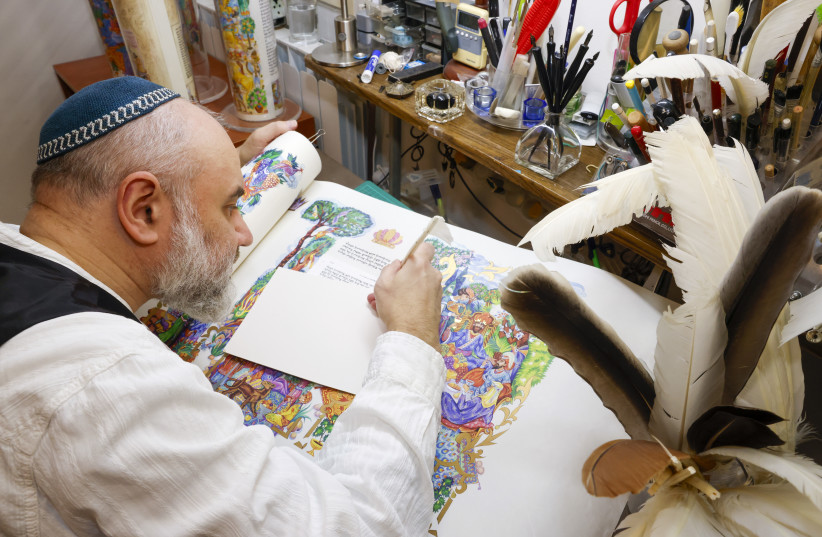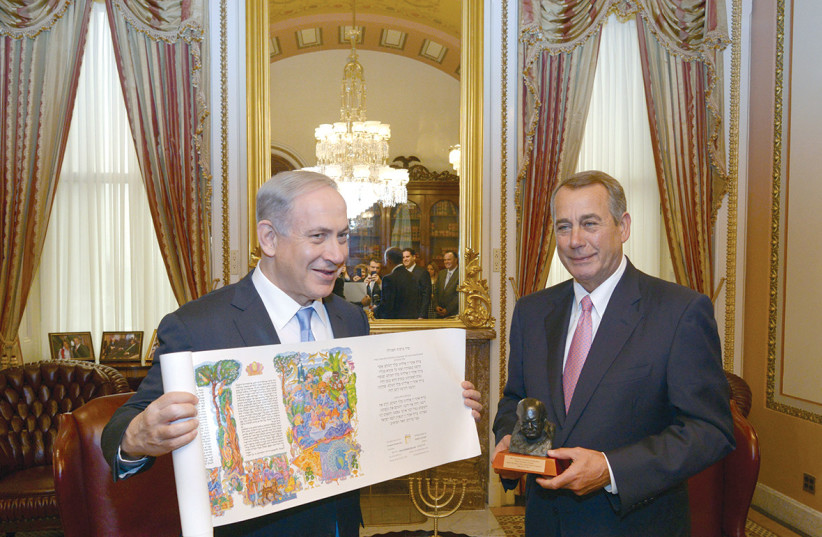
“Growing up in an assimilated family in the Soviet Union, I didn’t know Hebrew until age 18,” recalls master scribe and calligraphy artist Avraham Borshevsky.
Borshevsky, who holds two Guinness World Records for his work as a Jewish scribe, explains that when he was growing up, teaching Hebrew was forbidden in the Soviet Union. “Learners of Hebrew would go to prison, but I fell in love with Hebrew and was determined to learn, so I made my own personal Hebrew learning school and taught myself secretly at home,” he says.
“I first learned Hebrew by looking at black-and-white photographs of Hebrew texts, and that’s where my base in Hebrew came from,” he explains. Toward the end of perestroika, when regulations in the Soviet Union began to loosen a bit, Borshevsky was able to learn more openly at a synagogue, where he was able to meet with peers for the first time, to take his studies to the next level, and to quickly master Hebrew.
Finally, in 1990, the Borshevsky family had the opportunity to make aliyah. In the Jewish homeland he was accepted into the Shvut Ami Yeshiva in Jerusalem and began studies in architecture and art, where he first took a class in Jewish calligraphy and began his journey toward becoming a scribe. This has led him to the Talbiyeh studio, where his dreams have become tangible realities.
The world’s biggest and most expensive mezuzah
“For a long time, I dreamed of doing a [giant mezuzah as a] masterpiece project, for several reasons,” Borshevsky says. This finally came to fruition in 2004, when Borshevsky completed the world’s largest mezuzah, measuring 110 cm. in height and featuring a 76x94 cm. scroll.

“One reason [that I felt so compelled to finish this project] is that the mezuzah is a symbol of a Jewish home and is part of the essence of the people of Israel. I wanted to publicize this, to demonstrate to people all the work that’s contained within a mezuzah. Additionally, I wanted to make it into the Guinness Book of World Records in order for people to notice it and in order to spark more interest and passion for Judaism and Jewish roots,” Borshevsky explains. By including such a fundamental aspect of Judaism in something as mainstream as Guinness, he hoped to fight against assimilation and to bring Jews closer to their culture and to mitzvot.
“At first, there was a question of whether a mezuzah so large is kosher and permitted according to Halacha [Jewish law],” Borshevsky says. In the end, however, leading rabbis unanimously ruled such a large mezuzah to be not only kosher, but preferred. Since mezuzot are intended to serve as reminders of Hashem and His commandments, the bigger the better.
Ultimately, the world record, and the halachic rulings that accompanied it, also started a trend of people ordering bigger mezuzot, encouraging more pride in Judaism and serving as a bigger reminder of Jewish connection. Especially in these times of antisemitism and difficulties for the Jewish people, such outward expressions of Jewish culture, faith, and values are of the utmost importance.
The original giant mezuzah currently sits at the World Calligraphy Museum in Moscow. Borshevsky emphasizes that the price of the scroll is the gematria [Hebrew numerology] of the value of all the Hebrew letters contained within it. He proudly states that this fact, which was also included in the official Guinness Book of Records entry for the mezuzah, means that now even gematria, the mystic Kabbalistic practice of Jewish numerology, is discussed in something as mainstream and secular as the Guinness Records. For a Jew who was born in a time and place of “cultural genocide” where the mention or study of anything Jewish was forbidden, that’s quite a victory.
Other projects
In addition, Borshevsky creates original personalized gifts that connect to Jewish tradition and religion, and has worked with agencies like the Jewish National Fund, Keren Hayesod, and Yad Vashem. Regarding the latter, he is responsible, among other things, for making the official certificates awarded to those recognized as Righteous Among the Nations for saving Jews during the Holocaust.
Often, his work involves making gifts and prizes for donors to Israeli institutions, presenting him with the challenge of creating a suitable expression of gratitude for sometimes immense donations. He also is responsible for creating gifts that express the Jewish spirit and Jewish culture for visiting foreign signatories and presidents. As per Borshevsky’s website, among the owners of parchments with his signature are Benjamin Netanyahu, Naftali Bennett, George W. Bush, David Cameron, Vladimir Putin, Nursultan Nazarbayev, leading rabbis, Christian hierarchy, and businessmen from the Forbes list.
He also had the privilege of creating the award – a fully decorated handwritten parchment scroll of Song of Songs – posthumously bestowed upon Rabbi Lord Jonathan Sacks when he won the Genesis Prize in 2021, as well as certificates of excellence and heroism for soldiers, and the presidential guest book for foreign dignitaries and visitors at the President’s Residence. and more.
Borshevsky states that he loves this sort of work, creating personalized gifts and prizes with spiritual and symbolic meaning because it demands artistic creativity. For him, one of the most meaningful parts of his job is that he must consider the character of the recipients on a personal level, and then craft a gift that they will relate to and that will have spiritual meaning and significance for them.
The Scroll of Esther
“The Scroll of Esther is one of the first things that a student scribe learns because, unlike many scrolls, it does not contain the name of God in Hebrew, Hashem, meaning that it is more permissible to make mistakes. Additionally, since the Scroll of Esther is specific to Purim, which comes every year, there is always a market for them,” Borshevsky says.
His work is certainly not limited to one style, he explains: “Private individuals bring me their scrolls so that I can add crowns above the columns, or I can decorate the entire scroll, or I can write the names of the owners of the scroll inside the family crest.” Borshevsky adds that he has already hand drawn hundreds of unique and custom-made crowns.
The Royal Garden Esther Scroll featured here is particularly special because it is in the “king” style, meaning that each column is formatted and spaced such that it starts with word “king.” The thinking here is that even though Hashem is not mentioned anywhere in the scroll, “king” can be analogous to Hashem; therefore, starting each column with “king” emphasizes and extenuates the holiness of the work.

This scroll, however, has a special history. It was chosen by Prime Minister Benjamin Netanyahu for his 2015 visit to the White House, where he aimed to warn the world of the dangers posed by a nuclear Iran. Netanyahu presented the scroll, which itself documents the story of how Israel survived attempted genocide at the hands of the Persian Empire thousands of years ago, to then-US speaker of the house John Boehner.
At a time when the Jewish people once again face an existential threat emanating from Iran, Borshevsky’s scroll is a poignant reminder to the US government and the world of the importance of defending and standing with Israel.■
borshevsky.com/about
